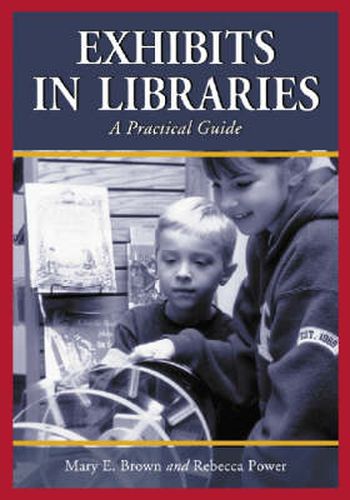Readings Newsletter
Become a Readings Member to make your shopping experience even easier.
Sign in or sign up for free!
You’re not far away from qualifying for FREE standard shipping within Australia
You’ve qualified for FREE standard shipping within Australia
The cart is loading…






This title is printed to order. This book may have been self-published. If so, we cannot guarantee the quality of the content. In the main most books will have gone through the editing process however some may not. We therefore suggest that you be aware of this before ordering this book. If in doubt check either the author or publisher’s details as we are unable to accept any returns unless they are faulty. Please contact us if you have any questions.
Library exhibits are more than entertainment for patrons. They can inspire and educate, stimulate an interest that can be explored in a book, or attract visitors who otherwise wouldn’t stop by. Displays are also an opportunity for a library to put its creative foot forward or help patrons navigate the facility itself. This comprehensive
how-to
includes everything a librarian or staff member needs to know to put on an exhibit, from hatching ideas to evaluating the end result. Illustrations and photographs show practical methods of planning, labeling and displaying. An introduction discusses the history and rationale of exhibits, and what librarians need to know to be responsible for them. Most the book’s pages, however, are dedicated to the hands-on process of creating an exhibit. The first part is a ten-step process for beginners. The second part includes everything a librarian or staff member might want to consider when creating an exhibit: the beginning idea (theme, goals, location); the development and design (layout, labeling and related concerns); the fabrication (materials and installation); and the exhibit from installation to removal (maintenance, care of volunteers, evaluation). Related issues include safety, administration, funding, contracts, public relations and other practical topics. Another section looks at special projects such as traveling displays and hands-on exhibits. Finally, the authors provide syllabi for continued study in a workshop or college course, along with a self-study guide.
$9.00 standard shipping within Australia
FREE standard shipping within Australia for orders over $100.00
Express & International shipping calculated at checkout
This title is printed to order. This book may have been self-published. If so, we cannot guarantee the quality of the content. In the main most books will have gone through the editing process however some may not. We therefore suggest that you be aware of this before ordering this book. If in doubt check either the author or publisher’s details as we are unable to accept any returns unless they are faulty. Please contact us if you have any questions.
Library exhibits are more than entertainment for patrons. They can inspire and educate, stimulate an interest that can be explored in a book, or attract visitors who otherwise wouldn’t stop by. Displays are also an opportunity for a library to put its creative foot forward or help patrons navigate the facility itself. This comprehensive
how-to
includes everything a librarian or staff member needs to know to put on an exhibit, from hatching ideas to evaluating the end result. Illustrations and photographs show practical methods of planning, labeling and displaying. An introduction discusses the history and rationale of exhibits, and what librarians need to know to be responsible for them. Most the book’s pages, however, are dedicated to the hands-on process of creating an exhibit. The first part is a ten-step process for beginners. The second part includes everything a librarian or staff member might want to consider when creating an exhibit: the beginning idea (theme, goals, location); the development and design (layout, labeling and related concerns); the fabrication (materials and installation); and the exhibit from installation to removal (maintenance, care of volunteers, evaluation). Related issues include safety, administration, funding, contracts, public relations and other practical topics. Another section looks at special projects such as traveling displays and hands-on exhibits. Finally, the authors provide syllabi for continued study in a workshop or college course, along with a self-study guide.